Forecast basics Identifying and understanding ingredients | Search for boundaries and gradients | Looking for what could go wrong :: Spotting basics Tornado shapes and sizes | Tornadic radar signatures
Nav SPC tornado/severe risks | Satellite/surface observations | Key ingredients | General links | NWS office links | Warnings
Tornado risk overview – Storm Prediction Center
The key things to know from the experts, select images for more info at source
Today’s tornado probabilities
The probability of a tornado within 25 miles of a point. If a hatched area is included in the image, which is only done with probabilities of 10 percent or higher, strong tornadoes are more of a concern than normal. The following tornado probabilities correspond to each SPC storm risk category.
See also: Maximum tornado probabilities by month and year
2%, Marginal | 5%, Slight | 10%, Enhanced (hatch = EF2+ greater risk) | 15%, Moderate (as above) | 30%, Moderate (if no hatch) | 30%+, High (hatch = EF2+ greater risk)
Current outlook areas, radar, and convective watches
Organized categorical risk of severe storms begins with “marginal” (MRGL). Levels increase from there to “slight” (SLGT), then “enhanced” (ENH), to “moderate” (MDT), and finally “high” (HIGH). In a marginal risk, one might expect mostly non severe storms, with perhaps an isolated severe weather incident. Severity is up from there, from short-lived in slight to more persistent in enhanced, long-lived in moderate, and exceptional in high. SPC has a graphic covering differences.
Watches, either tornado (red) or severe thunderstorm (blue), indicate that storms are likely to pose the highlighted threat. Tornadoes also occur in severe thunderstorm watches fairly frequently.
The days ahead
Tomorrow’s tornado probability (outlook)
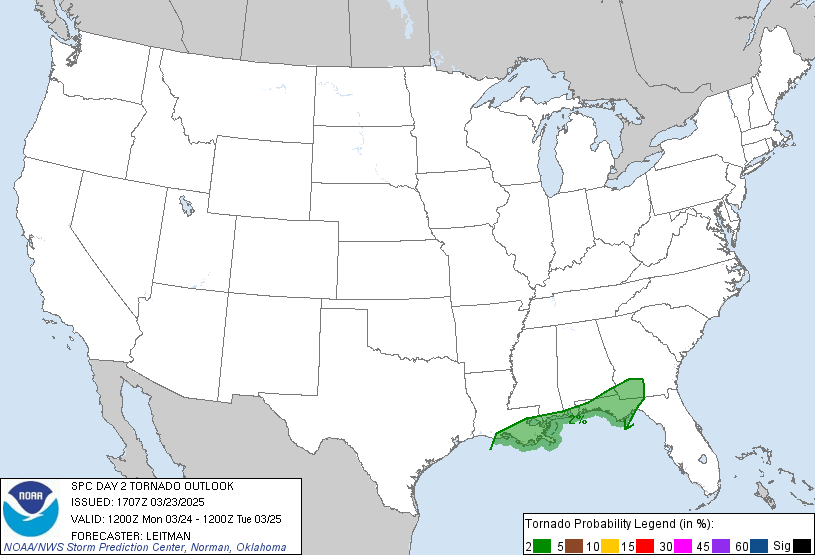
Day three severe weather outlook | Days 4-8 severe weather outlook
Satellite
Viewing storms from space

College of DuPage | NASA Regional Viewer (Visible, Infrared, Water Vapor)
Current surface conditions
A look at the key environmental factors
U.S. surface features
A surface feature analysis often tells the basic story of any weather setup. High pressure? Probably sunny. Low pressure? Probably stormy. When it comes to tornadoes, your classic setups involve a low pressure system (little red L above) to the northwest or west of the area of primary severe risk. Other features that help produce tornadoes include wind shift zones like the warm front (red lines with half-circle bubbles pointing in the direction of movement), surface trough/dry line (dashed orange line, often connected to a low), and in some cases the cold front (blue line with arrows pointing in the direction of movement).
SPC mesoanalysis pressure plot
U.S. observations, including wind speed and direction
Weather observations are critical to any severe storm forecast. The chart above is a simple one, and similar to the general surface feature map just above. When it comes to tornado forecasting, the quick items to look for in actual station observations that aren’t explicitly in the features map include: surface winds and temperatures, as well as dew points (more detail on that below). A critical component in tornadogenesis is “backing” low-level winds. In many warm-season cases, that means a southeasterly wind or close. In general, winds with a lengthy southerly component will efficiently transport moisture northward. Where winds shift, fronts or boundaries can be found.
U.S. temperatures

U.S. dewpoints

Key tornado indices via the Storm Prediction Center
These indicators are among the best
Surface based CAPE

CAPE, or Convective Available Potential Energy, is among the necessary ingredients for storms. If CAPE is zero, the atmosphere is stable. Measured in Joules per kilogram (j/kg), values near or over 500-1,000 j/kg are often about the low-end needed for widespread severe weather chances. Values over 3,000-4,000 are considered extremely unstable, often indicative of a high-end severe weather event. There are several layers of the atmosphere in which CAPE is measured, with surface CAPE among the most used to determine thunderstorm potential and gauge a severity ceiling.
A look at Cape | Examining CAPE
Bulk shear
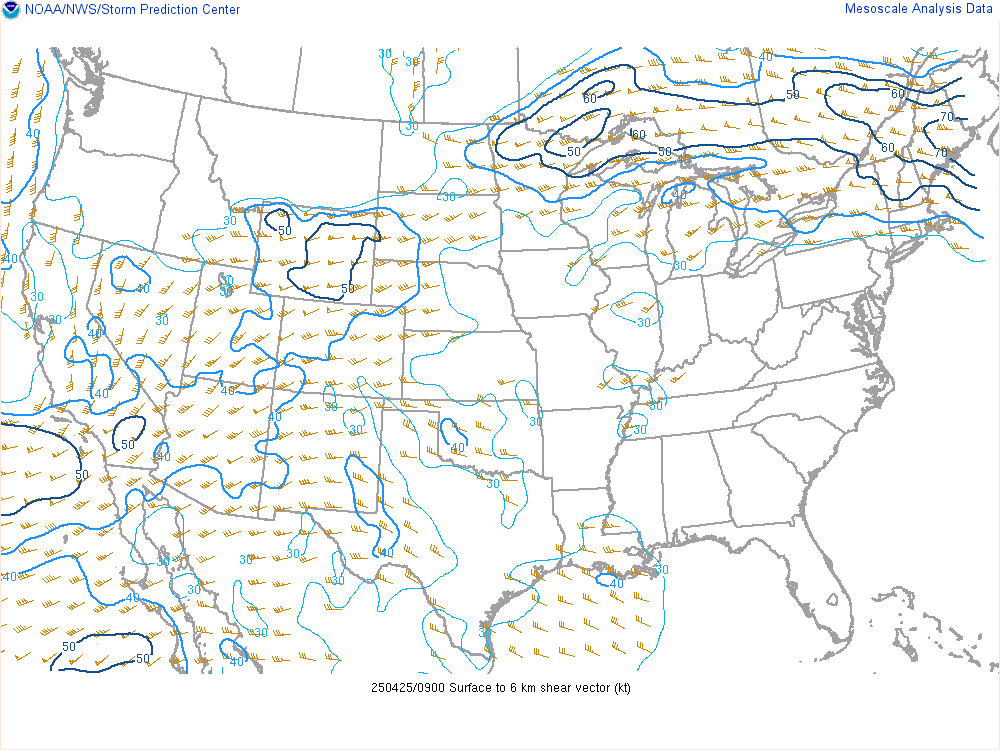
Bulk shear, or deep layer shear, is defined as the change in wind speed or direction within the lowest 6 km or 3.5 miles of the atmosphere. Bulk shear values of 40 knots or greater are supportive of supercells. Values lower, say between 30 and 40 knots, may also support supercells or supercell structures depending on the terrain and other ingredients. Larger bulk shear values tend to correlate to higher tornado potential, to a point at least.
Severe weather forecasting tip sheet (NWS, PDF)
Cheat code
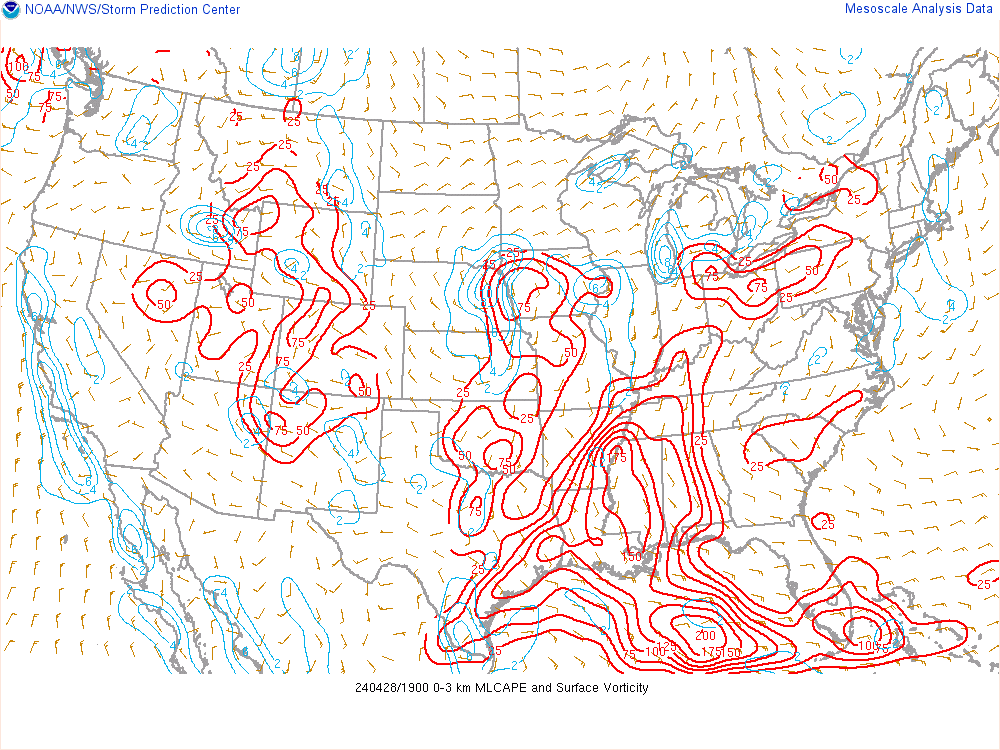
When it comes to 0-3 km CAPE and surface vorticity you look for the overlaps, go to them, and profit. Many people are saying Colin Davis was the first to call this a cheat code.
Supercell composite

Supercell composite is an index that includes several severe weather ingredients. The ingredients are effective storm-relative helicity, most unstable CAPE (muCAPE), and effective bulk wind difference. Values of 1 or greater indicate an increased potential for right-moving supercells, should storms fire or move into the region highlighted by the supercell composite index. More details can be found here.
Significant tornado
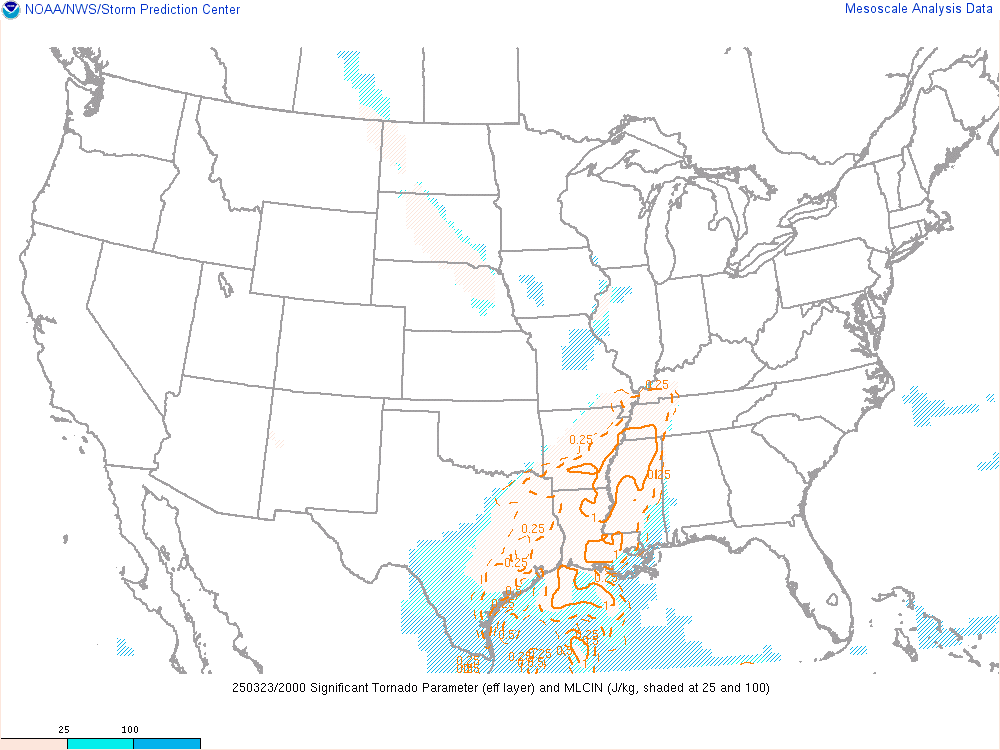
The significant tornado parameter (effective layer) is another composite index. Like the supercell composite, it contains several ingredients. The soup that makes up the significant tornado parameter includes effective bulk wind difference, effective storm-relative helicity, 100mb mean parcel CAPE (mlCAPE), and 100mb mean parcel height (mILCL). Values greater than 1 have been associated with a majority of tornadoes that have been rated significant/strong (which is a rating of F/EF2 or greater). Non-tornadic supercells, on the other hand, are often associated with significant tornado parameters of less than 1.
Surface-1km EHI

LCL Height
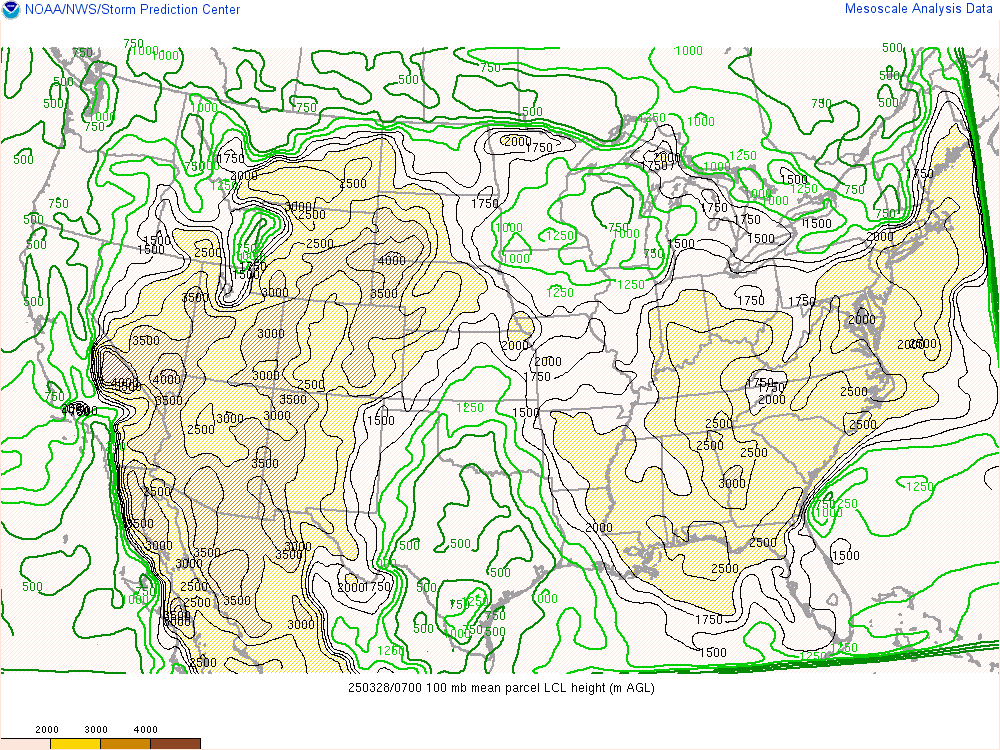
The Lifting Condensation Level (LCL) is the pressure level at which air reaches saturation upon being lifted. In more basic terms, it is often roughly where the base of a cloud should form as thunderstorm convection occurs during the warm season. Research has found that supercell tornadoes generally require LCLs below 1,500 meters. Strong tornadoes are more common with LCLs below 1,000 meters, and probably more in the 600 to 800 meter zone or lower. LCLs are often lower in a storm environment than shown in a large-scale analyses like above.
Hodographs! SPC recently added hodograph maps to their mesoanalysis. If you’ve seen our case archive, you know we love hodographs. Hodographs give a quick-look at the wind profile from the surface to the tropopause. Learning all the shapes can help your forecast immensely. Sadly, it is not available in CONUS so here are some direct links: South-Central | Central | North Central | Gulf Coast/South | Southeast/Mid Atlantic | Northeast/Great Lakes
Tornado and severe weather links
Key sources for forecasting tornadoes and severe weather
General tornado forecast tools
PivotalWeather.com Models | TwisterData.com Data and Models | COD Meteorology Model Page | SPC Short Range Ensemble Forecast (SREF) Page | SPC HREF Ensemble Viewer | Colorado State University Machine-Learning Probabilities
Short-term tools
SPC Mesoanalysis Pages | Radar derived hodographs | SPC Observed Soundings | CONUS Radar Loop (large)
Medium-to-long term tools
CIPS historical analog guidance (extended analogs) | Experimental Tornado Probability Based on GEFS Reforecasts | CFS Severe Weather Guidance Dashboard
Tornado watching tools
Tornado Intensity Reference Guide
Lightning tracking
Vaisala lightning network | LightningMaps.org – Real Time Lightning
NWS office links
Area Forecast Discussions
Southeast
(FL) Tallahassee, Jacksonville, Tampa, Melbourne, Miami, Key West (GA) Atlanta/Peachtree City (SC) Columbia, Charleston, Greenville/Spartanburg (NC) Wilmington, Morehead City, Raleigh
Mid-South
(AR) Little Rock (LA) Shreveport, Lake Charles, New Orleans (TN) Memphis, Nashville, Morristown (MS) Jackson (AL) Huntsville, Birmingham, Mobile
South/central Plains
(TX) Amarillo, Austin, Brownsville, Corpus Christi, Fort Worth, Houston, Lubbock, Midland, San Angelo (NM) Albuquerque (OK) Norman, Tulsa (KS) Dodge City, Goodland, Topeka, Wichita (CO) Denver, Pueblo
North/central Plains
(NE) Hastings, North Platte, Omaha (WY) Cheyenne (SD) Aberdeen, Rapid City, Sioux Falls (ND) Bismarck, Grand Forks (MT) Billings, Glasgow
Recent Tornado Warnings
Places at risk now or in the recent past
(return to top)
This page is undergoing development.


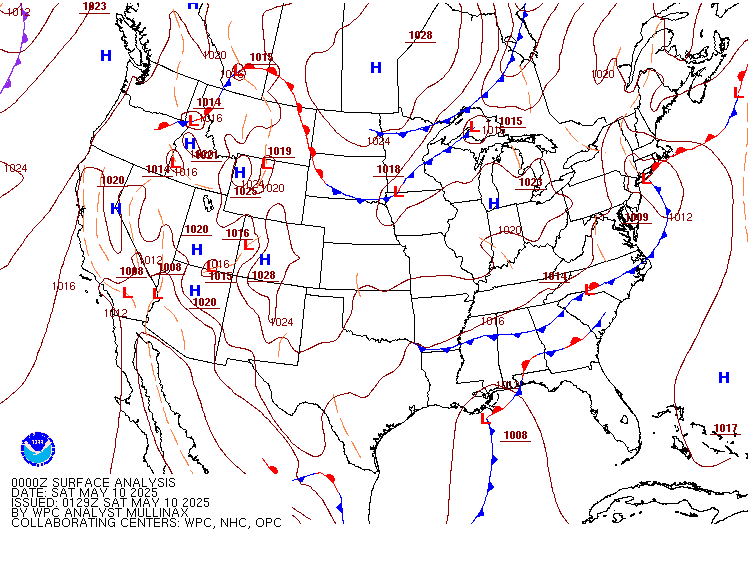
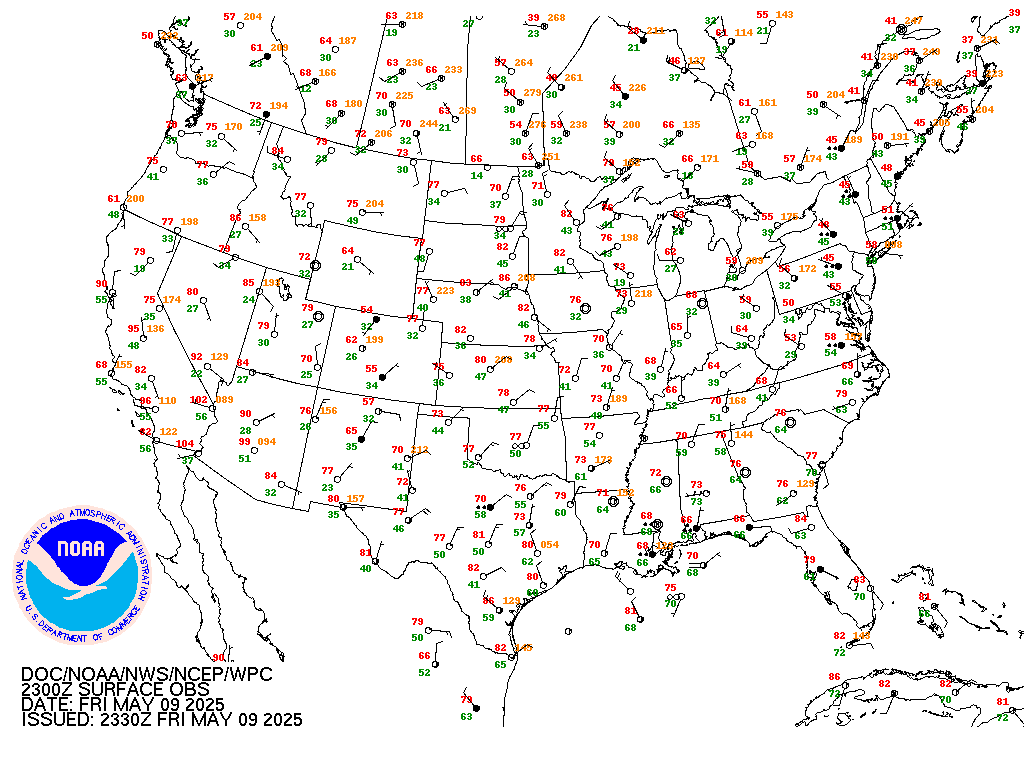
what does slgt mean
“SLGT” is a shortened form of “slight” risk on the convective outlook map.
There should be an “EXTREME” Risk, were Strong Winds Are 100% Happening, EF3+ Tornadoes, Big Hail, Long Tornado Outbreak. Extreme = EXE
They call that a PDS, or a Particularly Dangerous Situation.
WOW! YOU ARE REALLY SMART!!!! WOW!!!!!!!!
Don’t get to ahead of your self, but he is pretty smart!
Hi it’s Hannah Babcock and I want to ask you something what should I do to be a tornado tracker and chaser
Learn everything you can then learn more. Then go chasing with an experienced chaser or book a storm chasing tour. At that point you should know how to stay safe and enact good strategy. Tim Valquez (spelling may be off) has a great book to read called the storm chasers handbook. Beyond weather you need to know how to chase safely and have courtesy toward land owners locals and other chasers.
I am planning to be a storm chaser too! thanks for the idea i check the radar plus there were 7 spots in florida where some of them happen!
Idk man
Do you think there will be a tornado tomorrow in Ohio May 29 2019
that was the day i was in school and everyone got a tornado warning on their phones when i was in rowlett, tx but the tornado went to rockwall
Slight risk. Currently the first of three levels of severe outlooks from SPC, though this will be changing quite soon. Here’s something of an overview of both the original and the upcoming: http://www.washingtonpost.com/blogs/capital-weather-gang/wp/2014/01/15/weather-service-proposes-expanded-number-of-severe-weather-risk-categories-in-2014/
Or from SPC: http://www.spc.noaa.gov/faq/#3.3
What does mrgl and mdt and enh
Hi Romanatwood. They represent “Marginal”, “Moderate”, and “Enhanced” risk for severe weather. Go to the links Ian shared in his reply above, and they will explain what each type of risk means.
Is there a tornado today in Anna TX
well there is
Hahhahahahahahha loser doe
Thanks
I <3 tornados!
For sure
I HAVE a chance of a tornado
what is a “tornados” do you mean tornadoes?
Relax, they probably just forgot the “e”. And you’re making a big deal out of one mistake as if you’ve never made one before.
thanks so much for a wonderful site with an enormous ammount of CLEAR information!
How does convective available potential energy, bulk shear, lifting condensation levels and energy helicity index all work together for types of storms that tornado chances are higher in? I’d like to be a meteorologist some day. I’m very interested and I have been for awhile. Thank you for this site that shows all of the facts. It has been helpful👍👍
Thanks you for this site that shows all of the facts,it has been helpful
I <3 weather!!
Thanks for this awesome site!
hi i am william 9 years old but super smart anyways hurricane chris will turn to a hurricane cat 1 and 2
Hi Will! I´m also 9 years old and I´m also smart! ( In somethings )
I am nine ysr also to my Name Riley super smart also
And I also LOVE this site.It is the most amazing site I have ever been to.
hi I’m 10 and I love learning about tornados!
This is a good website and it’s very informative!! I have a few questions. Do/have tornados touched down in the same or general spot a number of times? I’m not talking about same cities hit over and over, but has the start point been the same? If so, hasn’t there been research done in regards to this as in, ground temps, humidity levels, barometric pressure readings, low and high level air temps in each recurrent case to find a correlation to add to the mystery of the other components of tornados??
yes 2 EF5 tornadoes hit the same spot in moore
that is really rare for 2 ef5 tornadoes to combine ef5 tornadoes happen mostly every 16 months and for that to happen there would be a really small chance
What is the probability of an overnight tornado in nova, just 30 minutes south of DC, 45 north of fredericksburg?
Very great page for checking weather
it would be better if it gave current warnnings or waches for storms
it does
Hi,i am from Sweden and live in North Thailand now.Sometimes i have se small “tornados”here.they start with wind and go up,3-4 times i have stop that only to break that with my foot when i put in my foot in virvel and brockend air to go up.
What i think maybe with dynamite or something go to break tornado and stop it when just start from landconnectien if that go and stopit to be big problem.
Hope inot take your time for what i only thinking.
Love this website! It has everything needed, especially for a beginner. Thank you!
Is there any risk for a tornado in RI this week or weekend?
if anyone wants a good app to track storms on then get my radar (not sponsored) lets you check warnings and watches with ease i use it to check the weather every day and i get an accurate image. this is also good if you are tracking tornadoes as there watches and warnings are purple.
is there going to be a tornado in granite city
Is there a tornado in Charleston, West Virginia on Thu. Oct. 31?
Is there going to be hail in fayette County Ga
will the tornado hit Newark De
a tornado will probably form in a zone of tornado alley it might hit missouri but thursday a tornado may strike in georgia whiches where a i live a texaes and of there palces in tornado alley will have extreme hail and tornadoes
Is their going to be a tornado in smith county, lindale Texas
I think there will be a tornado where I live ( Rhode Island ). My parts of my windows are breaking.
The rain is going insane and I feel like I’m going to die, and when I told my mom I wanted to see a tornado I didn’t actually wanted to be in one. So this is my first tornado and I’m freaking out and I have no idea what to do. 😰🌪
Come down
if you got my radar it haves a doppler radar which is crazy you can track tornadoes
there is another bad storm heading to the southeastern again for the third time but the most of the risk is at georgia where i live which is crazy we are going to be in the 30% chance of tornadoes on thursday
tomorrow is the day when tornadoes will strike in georgia which is scary beacause i live there in georgia it my be ef2 or higher im going to chase this storm and see wheres it heading on my dopplar radar
there is supercells in ok and tx this will be another outbreak do these storms hate the south we got the third diaster storms in a freaking row
i think jesus coming back to earth from all of these diasters anyways look on my radar if you want a doppler radar download my radar and you can chase every storm and tornadoes
if you go on tornado outlook you find out if any tornado that will be near or some where else
tornadoes will strike in georgia again tommorow
Dude stop blowing up the News🤣
for real
me im not
what does mrgl mean
everyone in central Illinois is in danger
Man, I love tornadoes and I want to be a tornado chaser when I grow up!
Me too,I have experienced a tornado
same the tonado had form behide my house
Their may be a tornado in Norfolk Va today,tommorow, or the day after that. We have about 50 mph wind gust right now! 🙂
be safe eveone
hope there’s no tornado today 🌪️
hi risk for flood in tennessee
Hi I do not want a storm to happen at all I want to have a nice sunny day
Is there going to be a tornado in Noblesville, Indiana today?
20% RISK OF HURRICANE fred near you. (in the future)
Hello! Good evening! Stay safe from storms!
Hi guys im 11 and I really love Tornadoes ive experienced 2 and there amazing just dangerous be carful everybody for this outbreak and if u see a tornado get to shelter and if u see one that seems not to move its coming right at you.
Same I would LOVE to be a storm chaser! TORNADOES ARE MY INSPIRATION!
hi i live in ga we had some bad weather today i am a 10 year old who likes hing with weather but here is the name of the weather website i use is called accuweather
we had bad weather to and i am logan michael lea and i live in galt mo and i am logan and i am 14
Um i live in sc but no tornadoes bless you all that have ones:(
I dont know what to say but my favorite storm chaser, Pecos Hank is SO GOOD i have seen a HUGE tornado in his vid when i see it i will tell you the name of the vid he is my inspration…
YES he chases the best storms i like his old vids with like those 1f4 wedge tornados
i wish i could live there too
I wouldnt those tornadoes are scary!
I know right I’m in school and there might be a tornado here in Alabama.
Do you see a horseshoe shaped cloud?
I think there will be a tornado in Texas Again!
1 tornado incoming on texas!! WARNING
can you add a feature that lets everyone know when and where a tornado is going?
can you add a thing that if you install it you can hear a tiny siren and it sends a message that tells you a tornado is coming! get to shelter! can you?
Hehe cant wait to grow up!
I wish there was a feature to send an alarm sending you info of where a tornado is going and what time
our last tornado was in april. weird lol
I want to be a meteorologist forecaster, this helps so much with that and my studies!
Hi, I Love This Site!
what is wrong with u i dont want a tornado in ohio i live in ohio
Im 17 and still very fearful of big storms like this. Im in the slgt risk for friday the 15th and im nervous about it since i wont be at school during it, my house is extremely old and breaking down and creaks and cracks in storms. Yet i am fascinated by storms as long as the done come to me. I used to wanna be a meteorologist when i was little
I survived the Joplin tornado of 2011 it was scary
You are so lucky!!!
Does anyone know where this Tornado is headed next
Thank you for all this info I use this app all the time for weather info! I love it
Im 12 years old and I want to become a storm chaser when i’m older. I Love Weather
I want to be a Meteorologist and maybe do storm chasing!!
Me too.😀
Hi I’m Jackson I’m 10 years old and live in Oklahoma and I’m am the biggest weather lover!! I just saw this website and it was so helpful because in spring there is so many storms, and the weather stations only put the tornado and severe risk up every so often. This has been really helpful especially with past storms.
is there going to be a tornado in Kentucky?
OMG I JUST HAD A TORNADO WARNING BUT HAF OF IT MISSED US!🙁😣😥😯😪😫🙁😓😔😕😖😷🤒🤕😞😟😲😢😭😦😧😨😩😬😰😱😳😵
wow that is crazy I hope you are okay!!
hi my name is ely wessels of missouri i am 12 years old im intrested in tornadoes i have a severe storm warning and moderate tornado chance tommarow i want to see a tornado.
don’t give away your age or name. people can steal your information. Dont do that on the internet. I would recommend telling your parent ts that you did so they can help you remove this comment.
I am glad that there are other kids that love weather like me because at school nobody likes weather and they all think I am weird.
Is their tornado in grande prairie
I thought this was helpful of you guys to let us know if there is ging to be a tonado or not
Wow useless and FaKE
There should be a severe risk on the spc. Severe means that winds of 140 mph or higher are possible. It comes before high. sev is what is short for the rating.
I’ve been looking for a website like this for so long. Thanks for that information.
i agree
I love this app and it is the best app that I can use for tornado tracking
Is it going to be a tornado today ???
i dont like today cuz of a tornado